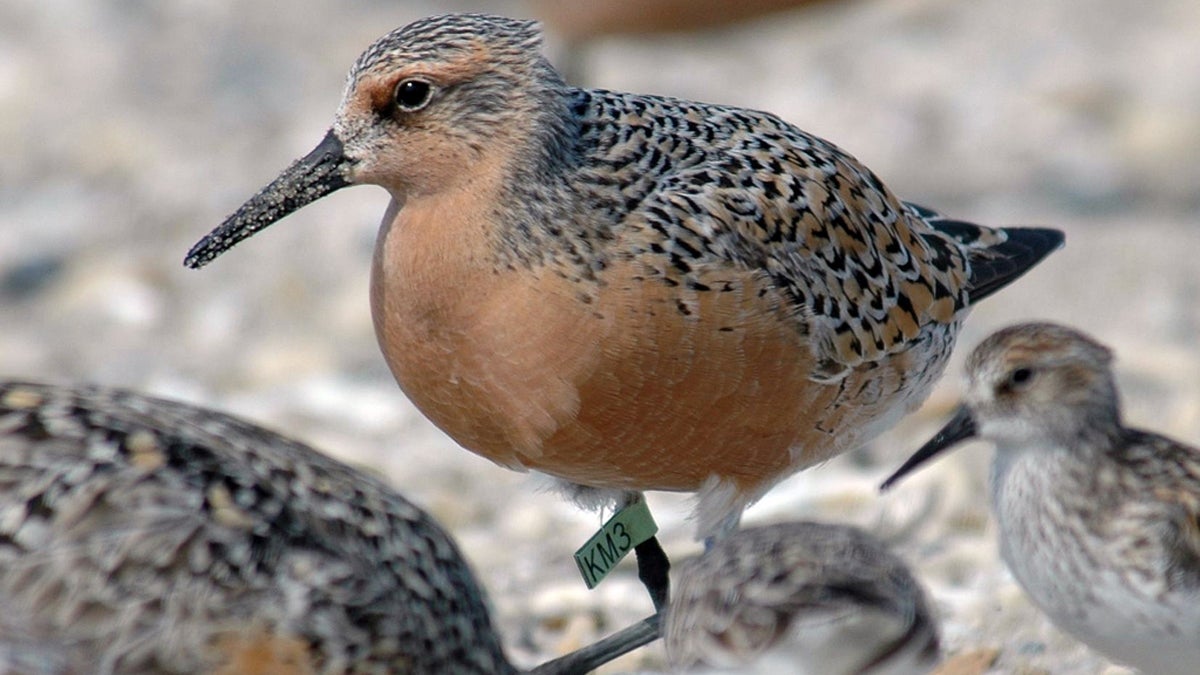Red knot shorebird added to U.S. list of threatened species
Listen
This photo provided by the US Fish and Wildlife Service shows a red knot in Mispillion Harbor, Delaware. (Gregory Breese, USFWS/AP Photo)
In recognition of its struggles with climate change and finding enough food, one subspecies of red knot now has federal protection under the Endangered Species Act.
The small shorebird, whose populations have dwindled in recent decades, flies 18,000 miles in a trip from Tierra del Fuego to the Canadian Arctic and back every year.
Kathy Clark, a biologist with New Jersey’s endangered species program, said red knots have a key stopover in the Delaware Bay in May.
“It gets them fueled up for the last leg of their journey which takes them to the Arctic tundra, where they breed.”
Dining on the eggs of horseshoe crabs, the birds can double their weight, Clark said.
Larry Niles, a wildlife biologist who proved instrumental in having the red knot recognized as threatened, recalled that in the 1980s, more than a million shorebirds, including the red knot, were feeding at the Bay.
“There were so many crabs that it was just unimaginable there would be any significant impact to them,” he said.
But then, he said, horseshoe crabs became valuable as bait.
Overharvesting of the crabs in the 1990s began the red knot’s decline, said David Mizrahi of the New Jersey Audubon Society. While the Bay is still a hotspot for birders come springitme, a survey in the 2000s found that only a quarter of the population remained.
Environmentalists and bird enthusiasts became alarmed, successfully petitioning the state of New Jersey to name the bird to its own threatened list in 2007. In what Niles described as a “courageous” move, legislators also made horseshoe crab harvesting illegal.
“We’re still the only state in the red knot’s mid-Atlantic range to have taken that step,” said Clark.
Although New Jersey also named the bird to its endangered list in 2012, that designation did not come with protections to its habitat. The red knot’s new status as “threatened” at the national level changes that.
“It sets up a layer of protection and review before activities could be engaged,” said Mizrahi. “That’s a major change in how you manage species and the kinds of activities that could go on.”
The U.S. Fish and Wildlife Service noted that red knots also face challenges from climate change, both in the Arctic and from sea level rise along the New Jersey and Delaware coasts.
“If those habitats aren’t able to migrate inland as sea levels rise,” said Mizrahi, “then we’re going to have a net loss of habitat that’s important for those birds.”
Niles, who is now with the American Littoral Society and Conserve Wildlife Foundation of New Jersey, said many birds can adapt to rising temperatures by shifting northward, but not the red knot doesn’t have that option.
“There’s one group of species that’s going to be left with nothing, and that’s the arctic species,” he said.
Red knot populations have rebounded to about 25,000 in recent years, Clark said, but they still remain far below their peak of around 80,000 in the 1980s.
WHYY is your source for fact-based, in-depth journalism and information. As a nonprofit organization, we rely on financial support from readers like you. Please give today.

